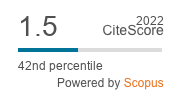Equine epaxial muscle size, thoracolumbar profile and symmetry in horses is of clinical interest due to relationships with pain and pathology. Flexible-curve rulers have previously been used to gather reliable, objective measures of thoracic profile, however, 3D light-scanning offers a potential non-contact alternative method to estimate cross sectional area (CSA) of the region. 3D light-scans of the thoracic epaxial region were taken from ten endurance horses (7 geldings, 3 mares; 8±2 years). Total CSA of the combined epaxial musculature, using computer software, was calculated at scapula and T18 levels (depth: 15 cm). Intra and inter-rater (n=3) reliability of CSA measurements was assessed using Friedman’s analyses and post-hoc Wilcoxon rank tests (three repeated measures). Intraclass correlation estimates (ICC ± 95% confidence intervals (CI)) were calculated (mean-rating, absolute-agreement, 2-way mixedeffects model). Paired t-tests assessed differences between right and left areas. No significant differences existed for transverse plane-cuts (scapula, T18 P>0.05) between light-scans. Right and left areas were significantly different at the withers (P=0.012) with the left side larger in 70% of scans, but no significant differences were found between sides at T18. No differences existed for different plane-cuts of the same horse (P=0.53; ICC: 0.76; CIs: 0.43-0.92). While reliability was reduced between all raters (P=0.02; ICC: 0.70; CIs: 0.56-0.82), no significant differences occurred between two different assessors experienced in using the software (P=0.88; ICC: 0.90; CIs: 0.82-0.95). Intra-rater reliability for assessing thoracic profile and inter-rater reliability ICC values with experienced analysts was interpreted as good/excellent. The results suggest 3D light-scanning is an objective, non-invasive method to record size and symmetry of the epaxial region in horses and warrants validity testing against current measurement methods such as the flexible-curve ruler.
RESEARCH ARTICLE
Use and repeatability of 3D light scanning to measure transverse dorsal profile size and symmetry in the thoracic region in horses
G.F. Tabor Related information
1Equine Performance Research Centre, Hartpury University, Gloucester GL19 3BE, United Kingdom.
*Corresponding author 1: gillian.
, D.J. Marlin Related information*Corresponding author 1: gillian.
2AnimalWeb Ltd., Tennyson House, Cambridge CB4 0WZ, United Kingdom.
*Corresponding author 2: dm@davidmarlin.
, J.M. Williams Related information*Corresponding author 2: dm@davidmarlin.
1Equine Performance Research Centre, Hartpury University, Gloucester GL19 3BE, United Kingdom.
Comparative Exercise Physiology: 18
(5)- Pages: 445 - 451
Published Online: October 07, 2022
Abstract
Keywords: equine, horse, objective, thoracic spine, outcome measurement, reliability
2023 Journal Impact Factor
0.9
source: Journal Impact Factor 2023™ from Clarivate™

Institutional Offers
For institutional orders, please contact [email protected].
Purchase Options
-
-
-
A. Byström, H.M. Clayton, E. Hernlund, M. Rhodin and A. Egenvall
-
L. Wright, E. Hernlund, C.T. Fjordbakk, B. Ytrehus, E. Law, M. Uhlhorn and M. Rhodin
-
Jane Williams and David Marlin
-
P.S. Rejeki, A. Pranoto, R.E. Prasetya and S. Sugiharto
-
A. Byström, H.M. Clayton, E. Hernlund, M. Rhodin and A. Egenvall
-
A. Andarianto, P.S. Rejeki, , A. Pranoto, T.W. Aga Seputra, and M. Miftahussurur
-
E.J. Hall and A.J. Carter
-
L. St. George, S.H. Roy, J. Richards, J. Sinclair and S.J. Hobbs



